On global estimates of monthly methane flux based on
observational data acquired by the Greenhouse gases
Observing SATellite "IBUKI" (GOSAT)
March 27, 2014 (JST)
National Institute for Environmental Studies
Ministry of the Environment, Japan
Japan Aerospace Exploration Agency
The Greenhouse gases Observing SATellite "IBUKI" (GOSAT), developed jointly by the Ministry of the Environment (MOE), the National Institute for Environmental Studies (NIES), Japan, and the Japan Aerospace Exploration Agency (JAXA) (hereafter the "Three Parties") is the world's first and only satellite designed specifically to monitor greenhouse gases from space. The satellite has continued to successfully fulfill its main function in monitoring atmospheric carbon dioxide (CO2) and methane (CH4) concentrations from space since it was first launched on January 23, 2009.
Global estimates of the monthly and regional net fluxes of methane (emission and absorption aggregates) were generated for the two years from June 2009 to May 2011, based on both observational data acquired by "IBUKI", and ground-based measurements.
There have been concrete demonstrations of the utility of the observational data acquired by "IBUKI". For example, the methane concentration data based on satellite observations has enabled us to quantitatively estimate global methane fluxes. When compared with methane flux estimates generated using ground-based observational data alone, estimates which incorporate the "IBUKI"-acquired observational data have significantly lower temporal and spatial uncertainties.
The GOSAT data allows producing more accurate estimates of both CO2 and CH4 fluxes. With this progress in global carbon cycle studies we can anticipate "IBUKI"'s future contributions to increasingly reliable climate change projections and global warming policy. The present methane flux estimates will be publicly disseminated by the Three Parties this summer, after their scrutiny by national and international researchers with relevant specialties.
1. Overview of the net methane flux estimates from "IBUKI"
(1) Summary of the methane concentration data from "IBUKI"
After carbon dioxide, methane is the greenhouse gas producing the highest radiative forcing1, and methane concentrations are over double the levels from before the Industrial Revolution, as a result of anthropogenic activities. Accurately monitoring changes in atmospheric methane concentrations and producing estimations of monthly and regional net methane fluxes are useful in facilitating a more accurate understanding of the detailed mechanisms of climate change and its influence on global warming.
An evaluation study2 has found that the "greenhouse gas observation sensor, TANSO-FTS" onboard "IBUKI" observes column-averaged concentrations of methane (the ratio of methane molecules relative to that of dry air, from the earth's surface to the upper extremities of the atmosphere) more accurately when compared with other satellite observations, and this study was quoted in the Intergovernmental Panel on Climate Change (IPCC) Working Group I Fifth Assessment Report. The mean difference (bias) and the standard deviation of the "IBUKI" data (Level 2 Version 2) are estimated at -0.006 ppm and 0.013 ppm3 by comparison with the observational data at the world-wide Total Carbon Column Observing Network's (TCCON)4 ground validation sites.
This means that the methane concentration data acquired by "IBUKI" is accurate to a bias of ~0.3% with a standard deviation of ~0.7%, from the global mean atmospheric methane concentration (global average of 1.82 ppm in 2012 (World Data Center for Greenhouse Gases)).
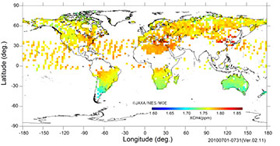
July 2010
|
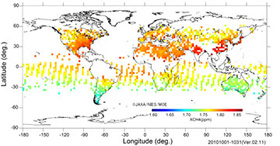
October 2010
|

January 2011
|
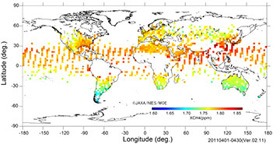
April 2011
|
Figure 1 Example of global distribution (2.5-degree mesh mean) of the monthly column-averaged concentration of methane.
Figure 1 shows an example of global distribution of the monthly column-averaged methane concentrations acquired by "IBUKI". It shows that methane concentrations have seasonal variations according to their location in the Northern Hemisphere, and that methane concentrations in the Northern Hemisphere are higher than those in the Southern Hemisphere over the course of a year.
(2) Results of methane flux estimates using both ground-based observations and IBUKI observational data
Methane is emitted from a variety of sources, widely distributed throughout the globe. Additionally, there are temporal and spatial variations in source strengths. As such, the surface observation network, consisting of approximately 100 observation sites, is not sufficient to quantitatively estimate the temporal and spatial distributions for the net flux of methane. For the current study, by adding the observational data on methane concentration as acquired by "IBUKI" to the measurements from the ground-based observation network5, the monthly net fluxes of methane (hereafter "Net Flux") were estimated over 43 regions for 24 months (June 2009-May 2011).
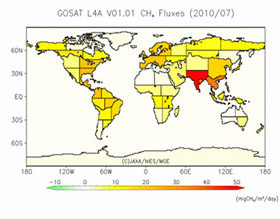
Monthly CH4 Net Flux (July 2010)
|
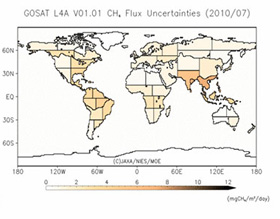
CH4 flux uncertainty (July 2010)
|

Monthly CH4 Net Flux (January 2011)
|
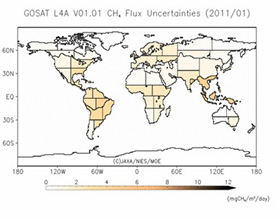
CH4 flux uncertainty (January 2011)
|
Figure 2 Example of monthly Net Flux and uncertainty
The Net Fluxes of methane in the 43 regions (figures on left), and their uncertainties (figures on right) estimated from the methane concentrations observed at the ground-based observation network sites (Note 1) along with those of "IBUKI". The upper panels indicate the results in July (summer in the Northern Hemisphere), 2010, and the lower panels indicate those in January (winter in the Northern Hemisphere), 2011. The color bar in the legend indicates the flux of methane, and the right is for the uncertainty of the estimation. The unit used is [mgCH4 m-2 day-1] (Note 2).
Figure 2 shows an example of monthly Net Flux estimates per region6 and their uncertainties. These results were obtained using an atmospheric transport model7 and an inverse model8, developed by NIES using the column-averaged methane concentrations based on the data acquired by "IBUKI" and the ground-based observation network. Figure 2 shows that there is a temporal variation in the regions which exhibit high emissions levels.
(3) Characteristics of the estimated annual flux of methane using observational data acquired by "IBUKI"
The annually averaged fluxes were calculated from the monthly regional estimates (Figure 3, two-year mean). The results show that several regions are responsible for high levels of methane emissions, and these are mostly consistent with areas of high population. Southeast Asia and the southern subtropics of South America and Africa are among the major methane emitters.

Figure 3 Estimation of the annual flux in each region
The annual Net Fluxes of methane estimated from the ground-based observational data and the observational data acquired by "IBUKI" (results based on the monthly fluxes from June 2009 to May 2011). The unit used is [TgCH4 region-1 year-1] - namely, the Net Flux of methane per region per year. It is found that the methane emissions in East Asia and the Southeast Asia region (Region No. 30, 32, and 34) are significantly high.
Methane is emitted from a wide variety of sources, including rice fields; wetlands; livestock; forest fires; and fossil fuel consumption - and is dissolved by chemical reactions with the OH radical9 in the air, or chlorine and excited oxygen atoms in the stratosphere. At present, methane emissions of anthropogenic origin are considered to be those of the greatest significance. Further methane emissions from permafrost thaw or large-scale forest fires are expected to accompany future global warming. It is thus imperative to monitor changes in concentrations and the Net Flux of methane.
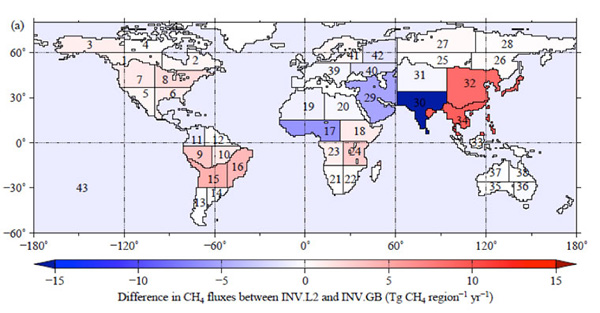
Figure 4 Change in the annual flux of methane per region
Changes in methane flux in the 43 regions with the addition of the "IBUKI" observational data to the ground-based observational data. The differences in the annual means of monthly fluxes from June 2009 to May 2011 were calculated. Regions where emissions are estimated as stronger are indicated in red and regions where emissions are estimated as weaker are indicated in blue. The methane emissions from the Asian region (Region No.32 and 34) and the southern subtropical areas of South America (No.9, 10, 15, and 16) and Africa (No. 24) became pronouncedly greater.
Estimations of annual methane emissions, which make use of the observational data acquired by "IBUKI" together with that from ground-based observations were higher than those produced using ground-based observations alone - in particular for Southeast Asia and the southern subtropical areas of South America and Africa (Figure 4). Moreover, there are differences in the seasonal variations of Net Flux for the estimates in some regions (not shown). Consequently, this indicates that "IBUKI" could potentially fill in the blanks left by the existing surface observation network, leading to new information about methane flux which cannot be attained using ground-based observations alone, in particular for the subtropical areas. "IBUKI" data is expected to provide further observational data of relevance to global carbon cycle studies - for instance which could improve a land ecosystem flux database with regards to methane emissions.
2. Further Steps
The present estimates of methane fluxes over the 43 regions throughout the globe will be evaluated by researchers in related fields, approved as Principle Investigators under the GOSAT Research Announcements, and through comparisons with similar estimates by other overseas institutes. Following the conclusion of this process, the present methane flux estimates will be publicly disseminated by the Three Parties this summer.
(pl.) A portion of the content of this release was produced under the grant-funded project "Characterization and Quantification of global methane emissions by utilizing GOSAT and in-situ measurements by the MOE Environment Research and Technology Development Fund" (ERTDF) A-1202.
Notes:
Note 1: Sink and emissions aggregate (difference in total levels of sink and those of emissions) including sink by chemical reaction with the OH radical in the atmosphere; sink in the stratosphere; absorption by land; emissions from rice fields, wetlands, livestock, forest fires, energy/industry, etc.
Note 2: The unit "mgCH4 m-2 day-1" denotes the amount of methane (in milligram) per square meter per day absorbed or emitted in the target region.
1 The difference between the earth's intake of radiated energy and that which is radiated back to space
2 Morino, I., et al., 2011: Preliminary validation of column-averaged volume mixing ratios of carbon dioxide and methane retrieved from GOSAT short-wavelength infrared spectra, Atmospheric Measurement Techniques, 4, 1061-1076
3 Yoshida, Y., et al., 2013: Improvement of the retrieval algorithm for GOSAT SWIR XCO2 and XCH4 and their validation using TCCON data, Atmospheric Measurement Techniques, 6, 1533-1547
4 International network of high resolution Fourier transform spectrum equipment which measures the column concentration of minor components of air, such as atmospheric carbon dioxide or methane (https://tccon-wiki.caltech.edu/).
5 Combined methane data that includes that from the ground-based observation sites and ships registered with the WDCGG of the World Meteorological Organization (WMO) (http://ds.data.jma.go.jp/gmd/wdcgg/jp/ wdcgg_j.html) and the aircraft monitoring data and the measurement data from the JR-STATION (tower) being carried out by the National Institute for Environmental Studies in Siberia.
6 The data from 86 observation sites were used for the calculation of methane flux.
7 Calculation program for the numeric simulation of transport and diffusion of minor components in air, such as carbon dioxide or methane, using meteorological data. The program is used to reproduce spatial distribution and changes in the concentrations of minor components.
8 Method for analyzing the monthly and regional net flux of methane from the observed concentration data using the atmospheric transport model (NIES-TM) developed by the National Institute for Environmental Studies. The meteorological data used (Japan Meteorological Agency Climate Data Assimilation System - JCDAS) is provided by the Japanese Reanalysis Project JRA-25 a long-run project of the JMA and the Central Research Institute of Electric Power Industry (CRIEPI).
9 The OH radical (hydroxyl radical) is an active radical of oxygen, and among the radicals of oxygen and hydrogen atoms with a strong oxidizing capacity. The chemical reaction with the OH radical is the main cause of dissipation of methane in the air.